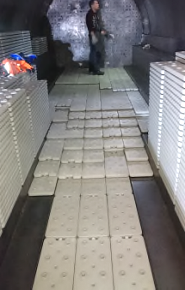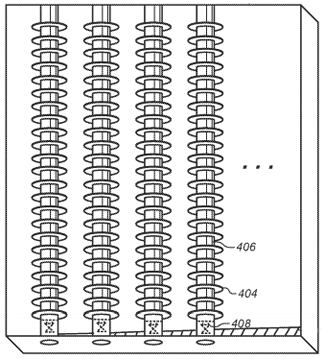 The Phase Change Matters e-mail newsletter is a weekly summary of the latest news and research on phase change materials and thermal energy storage. To subscribe, visit www.puretemp.com/subscribe. For more frequent updates, follow @puretemp on Twitter or visit the Phase Change Matters blog, www.puretemp.com/pcmatters.
The Phase Change Matters e-mail newsletter is a weekly summary of the latest news and research on phase change materials and thermal energy storage. To subscribe, visit www.puretemp.com/subscribe. For more frequent updates, follow @puretemp on Twitter or visit the Phase Change Matters blog, www.puretemp.com/pcmatters.
THERMAL ENERGY STORAGE
PCM-assisted cooling system designed to cut costs at Norwegian airport
A PCM-based thermal energy storage system at a new airport terminal in Bergen, Norway, is designed to reduce energy costs by chilling water overnight, when ambient temperatures are lower.
To handle peak demand during summer, Bergen Airport’s new Terminal 3 required a cooling system with a maximum output of 5 megawatts, said civil engineer Rune Teigland, who designed the system.
Instead, chillers with a maximum output of just 2.5 megawatts were installed. An additional 2.5 megawatts of cooling can be drawn from four large tanks that hold 44,000 panels filled with a salt-based phase change material. The PCM has a melting point of 10º degrees Celsius. The HDPE panels act as thermal batteries, holding the “chill” produced overnight for use during the day.
“The obvious advantage is that the cooling plant does not need to be big enough to handle the maximum cooling requirement. This offers some clear benefits, in terms of price, energy consumption and maintenance,” explained Teigland, a project leader at COWI of Lyngby, Denmark.
 The panels, supplied by U.K.-based PCM Products Ltd., are 50x25x3 centimeters in size and are stacked on top of each other in the water-filled tanks, each 13 meters long and 3 meters in diameter.
The panels, supplied by U.K.-based PCM Products Ltd., are 50x25x3 centimeters in size and are stacked on top of each other in the water-filled tanks, each 13 meters long and 3 meters in diameter.
When water at a temperature below the PCM’s freezing point is passed through the tanks, the PCM solidifies and energy is stored in the panels. When water is fed in at a temperature above the PCM’s freezing point, the PCM will melt and produce a cooling effect.
COWI says the system can run for two hours at full capacity solely on the energy stored in the PCM panels. The company projects an annual savings of 5,000 megawatt-hours compared to a conventional system.
“The method provides for big savings in energy and running costs, and we see great potential for buildings, data centers and production halls, for example, which need to keep both temperatures and CO₂ emissions down. This method could change the whole cooling industry,” said Teigland.
Teigland said he began “measuring and logging” system performance a few months before the terminal opened in August. He plans to submit a paper about the project to ASHRAE.
IN BRIEF
• A call for papers has been issued for the International Conference on Advanced Building Skins, to be held Oct. 1-2, 2018, in Bern, Switzerland. Among the topics: “Thermal performance of phase change materials for the building skin,” “Models, tools and simulations for sustainable buildings” and “Cost engineering and life cycle cost analysis.” The deadline for proposals is Feb. 15, 2018.
• 1414 Degrees of Australia has moved into a 3,000-square-meter factory on the site of the former Mitsubishi engine plant near Adelaide, where it will build its first 10MWh TESS-IND system and the first 13.3MWh test cell for a 200MWh TESS-GRID system. The company also plans to build two grid-scale silicon-based thermal energy storage systems in South Australia.
• ZAE-Bayern among more than 80 exhibitors scheduled to attend the 2018 Energy Storage Europe in Dusseldorf, Germany, March 13-15.
• New from QYResearch Group: “Global Smart Fabrics and Textiles Market Research Report 2017“
• The U.S. Department of Energy plans to request $99 million in fiscal year 2018 to support Energy Frontier Research Centers, which work to advance breakthroughs in materials sciences, chemical sciences, geosciences and biosciences.
• Glaciem Cooling Technologies of Australia won the “Applied Innovation” award at the inaugural Carbon Neutral Adelaide Awards last month. Glaciem’s ThermCOLD system uses a salt-based phase change material to store thermal energy, allowing refrigeration plants to run and store energy during off-peak periods, when electricity rates are lower, and then release energy during peak periods.
• Sonoco President and CEO Jack Sanders will retire in April, following a 30-year career with the packaging company. Chief Operating Officer Robert C. Tiede will replace Sanders as CEO.
• Singapore-based agribusiness giant Wilmar International has entered into an agreement to purchase Cargill‘s palm oil refinery and neighboring storage facility in Kuantan, Malaysia.
• The Lucerne University of Applied Sciences and Arts is seeking to hire a research associate for a seasonal thermal energy storage project. Responsibilities will include numerical and experimental investigation of the storage system in combination with phase change materials.
PATENTS
Free cooling in high humidity environments
 U.S. patent application 20170347499 (applicant Amazon Technologies Inc., Seattle, Wash.):
U.S. patent application 20170347499 (applicant Amazon Technologies Inc., Seattle, Wash.):
“A data center includes heat producing components and an air handling system that provides reduced relative humidity air to cool the heat producing components. The air handling system includes a thermal storage unit [section shown at right] that removes thermal energy from incoming air under a given set of ambient air conditions and releases thermal energy into incoming air under another set of ambient air conditions. Under the given set of ambient air conditions, the thermal storage unit cools the incoming air and causes water vapor to condense out of the incoming air. Under the other set of ambient air conditions, the thermal storage unit releases thermal energy into the incoming air, thus heating the incoming air. … [The] thermal storage unit may include a phase change material such as a paraffin wax, salt solution, an inorganic phase change material, or other suitable material with a high heat of fusion.”
Rubber or elastomer compositions and processes for their manufacturing
U.S. patent application 20170342240 (applicant Leibniz Institute for Polymer Research Dresden, Dresden, Germany):
“The present invention is concerned with the field of polymer chemistry and relates to rubber or elastomer compositions as can be used for vehicle tires, and to a method for the production of the rubber or elastomer compositions. The object of the invention is that in particular the elastic modulus of the compositions can be adapted depending on the temperature and/or the application conditions, and is a cost-effective and easily implemented method for the production of the compositions. The object is attained by rubber or elastomer compositions that contain at least one rubber or elastomer matrix and at least 20 to 150 phr of a phase change material in solid or liquid form.”
Non-combusting smoking article with thermochromatic label
U.S. patent application 20170340008 (applicant R.J. Reynolds Tobacco Co., Winston-Salem, N.C.):
“A smoking article is disclosed herein. The smoking article includes a shell defining an interior space, a consumable substance within the interior space, a heat source effective to increase the temperature of at least a portion of the shell, and a label attached to at least a portion of the shell. The label includes a base film, a cover film, and a temperature dependent material disposed between the base film and the cover film. The temperature dependent material is configured to transition between a first appearance and a second appearance responsive to the increase of the temperature of at least a portion of the shell. … In some embodiments, the temperature dependent material may be a reversible thermochromatic ink or a reversible phase change material that may transition from a colored, opaque cool state to a substantially transparent warm state to effect the change in appearance. “
RESEARCH ROUNDUP
For our full list of recent academic research, see puretemp.com/academic. Here are highlights from the past week:
From Applied Energy:• Optimized demand side management (DSM) of peak electricity demand by coupling low temperature thermal energy storage (TES) and solar PV
From Energy and Buildings:
• Performance of a thermal energy storage composite by incorporating diatomite stabilized paraffin as phase change material
From Energy:
• Enhancement in free cooling potential through PCM based storage system integrated with Direct Evaporative Cooling (DEC) unit
From International Journal of Heat and Mass Transfer:
• Investigation of solid-liquid phase change in the spherical capsule using axisymmetric lattice Boltzmann model
• Heat transfer analysis of microencapsulated phase change material slurry flow in heated helical coils: A numerical and analytical study
From Cost-Effective Energy Efficient Building Retrofitting:
• Phase Change Materials for Application in Energy-Efficient Buildings
From Calphad:
• Thermodynamic assessment of binary erythritol-xylitol phase diagram for phase change materials design
From Thermal Transport in Carbon-Based Nanomaterials:
• The Application of Carbon Materials in Latent Heat Thermal Energy Storage (LHTES)
From Applied Thermal Engineering:
• Thermal Properties Optimization of Microencapsulated a Renewable and Non-toxic Phase Change Material with a Polystyrene Shell for Thermal Energy Storage Systems
From Royal Society of Chemistry:
• H2O2-microwave treated graphite stabilized stearic acid as a composite phase change material for thermal energy storage
From Sustainable Cities and Societies:
• Experimental test bed design and development for PCM-water exchangers characterization
From Polymer:
• Synthesis of novel phase change material microcapsule and its application
From Building Services Engineering Research & Technology:
• Sodium acetate–urea composite phase change material used in building envelopes for thermal insulation
From Sustainable Chemistry & Engineering:
• Integration of Pore Confinement and Hydrogen-Bond Influence on the Crystallization Behavior of C18 PCMs in Mesoporous Silica for Form-Stable Phase Change Materials
NETWORKING
Connect with PCM experts and industry leaders on LinkedIn
More than 1,100 people have joined a LinkedIn group devoted to the discussion of phase change material and thermal energy storage. The Phase Change Matters group is an interactive complement to the award-winning blog and newsletter of the same name.
 You are invited to join the group and connect with PCM and TES experts from around the world. New members include Dr. Hakan F. Oztop, professor of mechanical engineering at Fırat University, Elazığ, Turkey; Irina Safonova, materials scientist, Tampere, Finland; Dr. Anne Prahl, design research and innovation consultant, London, United Kingdom; Francesco Clementi, system engineer leader at Electrolux, Motta di Livenza, Italy; and Rune Teigland, project leader at COWI, Lyngby, Denmark.
You are invited to join the group and connect with PCM and TES experts from around the world. New members include Dr. Hakan F. Oztop, professor of mechanical engineering at Fırat University, Elazığ, Turkey; Irina Safonova, materials scientist, Tampere, Finland; Dr. Anne Prahl, design research and innovation consultant, London, United Kingdom; Francesco Clementi, system engineer leader at Electrolux, Motta di Livenza, Italy; and Rune Teigland, project leader at COWI, Lyngby, Denmark.